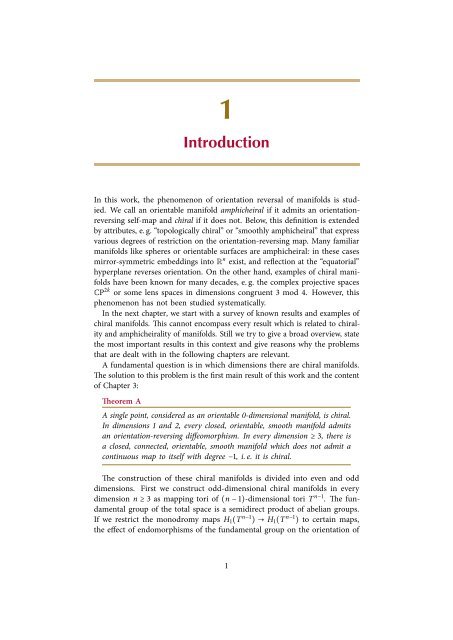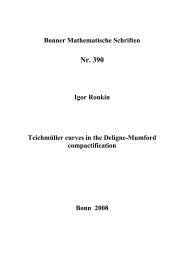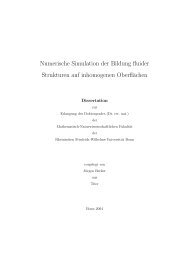Orientation reversal of manifolds - Universität Bonn
Orientation reversal of manifolds - Universität Bonn
Orientation reversal of manifolds - Universität Bonn
Create successful ePaper yourself
Turn your PDF publications into a flip-book with our unique Google optimized e-Paper software.
1<br />
Introduction<br />
In this work, the phenomenon <strong>of</strong> orientation <strong>reversal</strong> <strong>of</strong> <strong>manifolds</strong> is studied.<br />
We call an orientable manifold amphicheiral if it admits an orientationreversing<br />
self-map and chiral if it does not. Below, this definition is extended<br />
by attributes, e. g. “topologically chiral” or “smoothly amphicheiral” that express<br />
various degrees <strong>of</strong> restriction on the orientation-reversing map. Many familiar<br />
<strong>manifolds</strong> like spheres or orientable surfaces are amphicheiral: in these cases<br />
mirror-symmetric embeddings into R n exist, and reflection at the “equatorial”<br />
hyperplane reverses orientation. On the other hand, examples <strong>of</strong> chiral <strong>manifolds</strong><br />
have been known for many decades, e. g. the complex projective spaces<br />
CP 2k or some lens spaces in dimensions congruent 3 mod 4. However, this<br />
phenomenon has not been studied systematically.<br />
In the next chapter, we start with a survey <strong>of</strong> known results and examples <strong>of</strong><br />
chiral <strong>manifolds</strong>. This cannot encompass every result which is related to chirality<br />
and amphicheirality <strong>of</strong> <strong>manifolds</strong>. Still we try to give a broad overview, state<br />
the most important results in this context and give reasons why the problems<br />
that are dealt with in the following chapters are relevant.<br />
A fundamental question is in which dimensions there are chiral <strong>manifolds</strong>.<br />
The solution to this problem is the first main result <strong>of</strong> this work and the content<br />
<strong>of</strong> Chapter 3:<br />
Theorem A<br />
A single point, considered as an orientable 0-dimensional manifold, is chiral.<br />
In dimensions 1 and 2, every closed, orientable, smooth manifold admits<br />
an orientation-reversing diffeomorphism. In every dimension ≥ 3, there is<br />
a closed, connected, orientable, smooth manifold which does not admit a<br />
continuous map to itself with degree −1, i. e. it is chiral.<br />
The construction <strong>of</strong> these chiral <strong>manifolds</strong> is divided into even and odd<br />
dimensions. First we construct odd-dimensional chiral <strong>manifolds</strong> in every<br />
dimension n ≥ 3 as mapping tori <strong>of</strong> (n − 1)-dimensional tori T n−1 . The fundamental<br />
group <strong>of</strong> the total space is a semidirect product <strong>of</strong> abelian groups.<br />
If we restrict the monodromy maps H 1 (T n−1 ) → H 1 (T n−1 ) to certain maps,<br />
the effect <strong>of</strong> endomorphisms <strong>of</strong> the fundamental group on the orientation <strong>of</strong><br />
1





